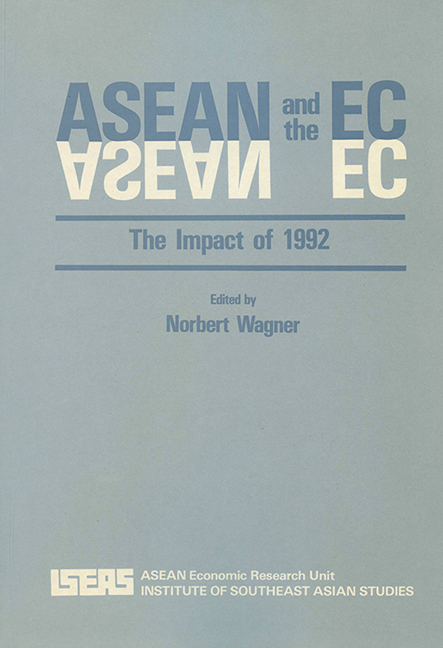Book contents
- Frontmatter
- Contents
- List of Tables
- List of Figures
- Acknowledgements
- PART I INTRODUCTION
- PART II COMPLETING THE EC INTERNAL MARKET
- PART III IMPLICATIONS FOR ASEAN
- V An Analysis of ASEAN-EC Trade in Textiles and Electronics, 1980–88
- VI The EC Internal Market and the ASEAN Electronics Industry
- VII The EC Internal Market and the ASEAN Textile and Clothing Industry
- VIII The Harmonization of Technical Standards and Regulations in the EC: Implications for ASEAN
- IX The EC Internal Market and ASEAN-EC Trade in Services
- X The EC Internal Market and ASEAN-EC Direct Investment Flows
- XI The European Currency System and ASEAN
- Contributors
VII - The EC Internal Market and the ASEAN Textile and Clothing Industry
from PART III - IMPLICATIONS FOR ASEAN
Published online by Cambridge University Press: 09 November 2017
- Frontmatter
- Contents
- List of Tables
- List of Figures
- Acknowledgements
- PART I INTRODUCTION
- PART II COMPLETING THE EC INTERNAL MARKET
- PART III IMPLICATIONS FOR ASEAN
- V An Analysis of ASEAN-EC Trade in Textiles and Electronics, 1980–88
- VI The EC Internal Market and the ASEAN Electronics Industry
- VII The EC Internal Market and the ASEAN Textile and Clothing Industry
- VIII The Harmonization of Technical Standards and Regulations in the EC: Implications for ASEAN
- IX The EC Internal Market and ASEAN-EC Trade in Services
- X The EC Internal Market and ASEAN-EC Direct Investment Flows
- XI The European Currency System and ASEAN
- Contributors
Summary
As 1992 approaches, there is much discussion of the effects of the single market on third countries. The main concern of third countries is the creation of a “fortress Europe” rather than a Europe that will share its “prosperity” with the rest of the world. One of the traditionally sensitive sectors already subject to import restrictions is the textile and clothing industry. Since the EC market is one of the most important markets for textiles and clothing from countries of the Association of Southeast Asian Nations (ASEAN), it is useful to analyse how full economic integration of the European Community (EC) will affect its exports of textiles and clothing.
The aim of this chapter is to look into the various possible scenarios of the impact of the formation of the EC single market on third country imports of textiles and clothing. This includes an examination of the impact of specific EC policies on textiles and clothing on third countries, as well as any impact arising from changes in the textile and clothing industry in the EC countries after the formation of the single market.
The rest of this chapter is divided into five sections. The first section provides a general background of trends in textile and clothing production, employment, and trade of the EC and ASEAN countries relative to other countries. The second section compares the characteristics of the textile and clothing industry in each region. The third section describes EC policies towards third countries on textiles and clothing and the impact on the ASEAN countries up to the present time. We then look into a set of alternative scenarios regarding the impact of the EC single market on ASEAN trade in textiles and clothing. Some conclusions and recommendations are provided at the end of the chapter.
General Trends in Production, Employment, and Trade in Textiles and Clothing
To understand EC policies on textiles and clothing, we begin with a background on the trends in production, employment, and trade in textiles and clothing of the EC and ASEAN countries relative to other countries.
- Type
- Chapter
- Information
- ASEAN and the ECThe Impact of 1992, pp. 190 - 240Publisher: ISEAS–Yusof Ishak InstitutePrint publication year: 1991

